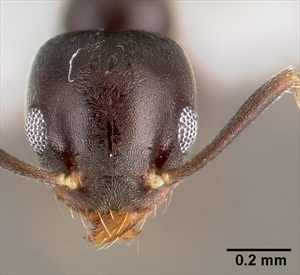- Worldwide distribution. In Australia, Guam, Federated States of Micronesia (Chuuk), Papua New Guinea. Several similar species requiring expert identification.
- Major pest. Damage is indirect: ant protects aphids, mealybugs, scales, whiteflies from natural enemies encouraging pest outbreaks. Nests on ground, in trees, in houses. Does not bite humans.
- Males, winged and wingless; females (queens, workers, 'intercastes'). Queens mate, establish colony; later, reproductive (fertilized) intercastes take over. Foraging by (unfertilized) workers - food is living/dead insects, honeydew, own eggs.
- Tramp ant; spread by 'budding' - intercastes leave nest with workers, males and brood; spread with international horticultural trade.
- Biosecurity: requires risk assessments, regulations preventing introduction, protocols in case of breach, and ability to make rapid response. Pacific Ant Prevention Plan available (IUCN/SSC Invasive Specialist Group).
- Cultural control: hot water at 47°C kills ants; over 49°C kills plants.
- Chemical control: use (i) stomach poisons (fipronil, Amdro®, borax), (ii) growth regulators (methoprene, pyriproxyfen), (iii) nerve poisons (bifenthrin, fipronil, imidacloprid). See (http://piat.org.nz/index.php?page=getting-rid-of-ants).







